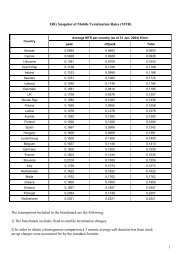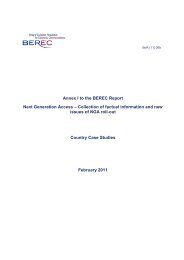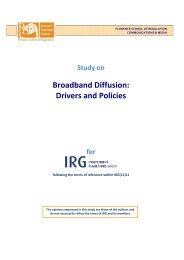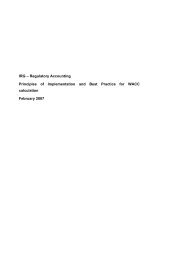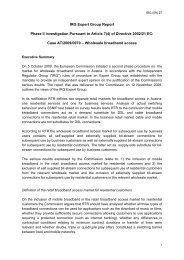16 Rev2b NGA Opinion Supplementary doc - IRG
16 Rev2b NGA Opinion Supplementary doc - IRG
16 Rev2b NGA Opinion Supplementary doc - IRG
Create successful ePaper yourself
Turn your PDF publications into a flip-book with our unique Google optimized e-Paper software.
ERG (07) <strong>16</strong>rev2b <strong>NGA</strong> <strong>Opinion</strong> <strong>Supplementary</strong> Doc 9 / 69<br />
Question Chapter 3: Do you agree/disagree with regard to the<br />
conclusions on economics and business case<br />
studies?<br />
ad 3.2 Implications of <strong>NGA</strong> on the economics of electronic communications networks<br />
Consultation Comments<br />
There was a wide range of comments relating to the implications of economics of <strong>NGA</strong>.<br />
Several respondents commented that the economics of <strong>NGA</strong> varied substantially between<br />
geographic areas. One comment identified 3 types of areas identified (market led = urban,<br />
risk driven = suburbs and policy driven = rural areas) and that economics and regulation varies<br />
between them (Alcatel). Two others commented that that business cases for <strong>NGA</strong> may<br />
vary substantially between areas (BSG, BT).<br />
The economics of infrastructure competition were also raised by some players, and demonstrated<br />
another wide range of responses:<br />
• SLU is not economically viable (BT);<br />
• Competition at the cabinet is difficult and so WBA service requirements should be imposed<br />
on incumbent (KPN);<br />
• Ability to co-locate at incumbent cabinet, rather than having to locate nearby improves<br />
viability of sub-loop unbundling remedies. (ARCOR).<br />
An incumbent believes there is scope for altnets to deploy alternative infrastructure in urban<br />
areas (TI, similar AFORST).<br />
Several respondents commented about the relative cost structures faced by incumbents and<br />
entrants in relation to <strong>NGA</strong>:<br />
• Several altnets stressed that <strong>NGA</strong> costs and cost savings should be considered together.<br />
<strong>NGA</strong> may enable incumbents to make savings but could lead to higher costs<br />
for altnets.<br />
o A stakeholder association stressed that the cost data and ARPU assumptions<br />
being made related to an incumbent rather than an altnet (ECTA) ;<br />
o A competitor also commented that it is important to distinguish between costs<br />
and ARPU of incumbents and of altnets (Tele2);<br />
o Another competitor noted that economies of scale enjoyed by incumbents<br />
make it harder for altnets to recover infrastructure costs (Fastweb) ;<br />
o A manufacturer acknowledged that fibre deployments may be justified on basis<br />
of OPEX savings (Ericsson).<br />
In relation to the access network being a bottleneck, there was a feeling from altnets that<br />
<strong>NGA</strong> increased the scope for the access to be a bottleneck:<br />
• A competitor suggested that <strong>NGA</strong> may increase the scope of this (C&W). Interestingly,<br />
a comment suggested that, in the short term, one should not assume that <strong>NGA</strong><br />
will be a bottleneck asset if copper is maintained (BSG).<br />
• A stakeholder association agrees that existing legacy advantages and scale economies<br />
are likely exacerbated thereby reinforcing bottlenecks (ECTA).



